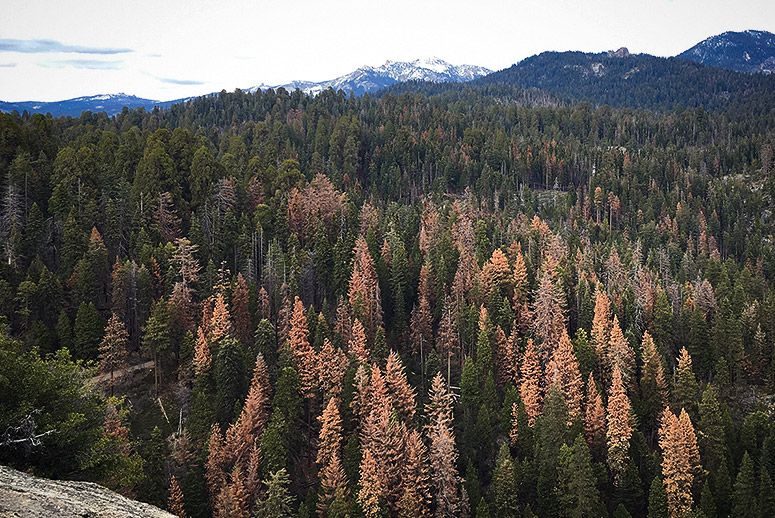26 MILLION TREES DIED IN CALIFORNIA IN JUST ONE YEAR
The mortality rate is unprecedented and will fuel the state’s fire season.
Sequoia National Park. (Photo: USFS Region 5/Flickr)
TAKE PART DAILY
Taylor Hill
The number of dead trees in California’s forests dramatically increased in just one year’s time.
The latest survey from the United States Forest Service revealed that an additional 26 million trees have succumbed to drought, a devastating bark beetle infestation, and hotter temperatures in 2015. That brings the number of trees that have died in the Sierra Nevada to 66 million since 2010.
For a state already in the throes of fire season, the discovery of a 65 percent increase in the number of dead trees within its forests is a troubling sign.
“These new numbers really show that the tree die-off is spreading at an astronomical rate,” said Amy Head, a Cal Fire education officer. “It’s unprecedented, and it’s changing the landscape of whole ecosystems in California.”
The new figures are based on a May aerial survey assessment that found millions of new dead trees across the state. The southern portion of the Sierras—from Tuolumne County down to Kern County—shows the most severe tree mortality rates per acre.
Tiny holes from bark beetles in tree in Sierra National Forest. (Photo: USFS Region 5/Flickr)
The issue is the persistent drought. Bark beetles have been having a field day on the state’s weakened trees. Typically the trees are strong enough to withstand the beetles’ attack, using sap, or “pitch,” to keep the tiny pests from infiltrating the wood, planting larvae, and cutting off the tree’s flow of nutrients from the leaves to the trunk. But with ever-increasing temperatures and less water, the stressed trees can’t put up a fight.

“Most species of bark beetles in California are native, they’ve been around here for a while, so that’s not a new threat,” Head said. “The issue now is there are a tremendous amount of trees already weakened when the beetles come in, and they can’t fend them off.”
RELATED: The Redwoods’ Last Stand
And droughts like the one California is currently mired in will only grow more severe. Research conducted last year found that climate change made California’s drought 15 to 20 percent worse.
That’s left the state’s forests littered with 100-foot-tall matches ready to ignite—and led Gov. Jerry Brown to call a state of emergency during last year’s fire season. An extra $32 million in funding was dedicated for forest restoration work, including removing more than 77,000 dead trees located near urban centers and homes.
Advertisement
But that’s just a drop in the bucket compared with what the Forest Service believes it needs to adequately protect the nation’s forest from devastating wildfires. Just last year, the agency spent more of its allocated budget on fighting wildfires than on all other services combined.
U.S. Agriculture Secretary Tom Vilsack estimates that by 2025, fighting wildfires will take up two-thirds of Forest Service funding—or nearly $1.8 billion—as summer temperatures continue to rise, and fire seasons continue to lengthen.
Vilsack sees the move in California to pay for fire suppression through emergency action as a way to change the way firefighting is funded. Instead of coming out of the Forest Service’s regular annual budget, wildfire fighting would be funded according to the severity of each season—similar to how Congress funds other natural disasters.
“While the fire risk is currently the most extreme in California because of the tree mortality, forests across the country are at risk of wildfire and urgently need restoration requiring a massive effort to remove this tinder and improve their health,” Vilsack said in statement. “Unfortunately, unless Congress acts now to address how we pay for firefighting, the Forest Service will not have the resources necessary to address the forest die-off and restore our forests.”
Inside The Business of Organics
Embed This Infographic on Your Site<img alt=”Inside The Business of Organics” src=”http://www.takepart.com/sites/default/files/us-forest-map-small.jpg”>
Via: TakePart.com








The beetles come after the tree is sick. They are not the cause of the sickness. Yes drought but what about the aluminum oxide nano particles taken up by the trees and other biological life. Geoengineering aerosol spraying and microwave radiation moving create a weather monster that is continuing to decimate life.
Check out Geoengineering the patents started in the 1940’s and the systems were used in every war and conflict and are currently causing drought and extreme weather events where ever there is resistance to the Globalist Cabal.